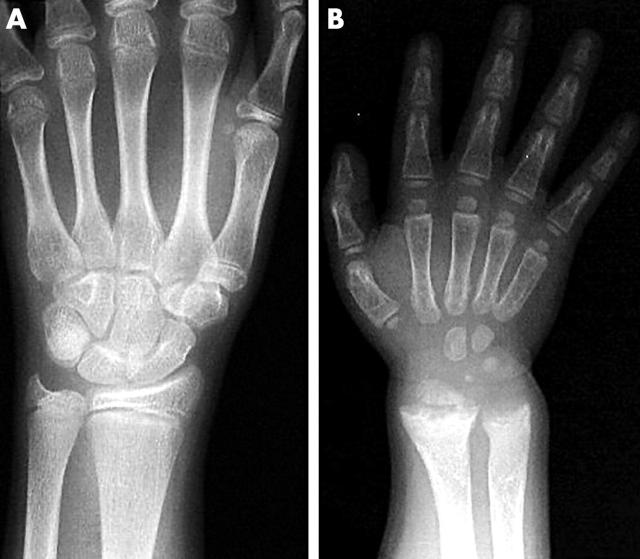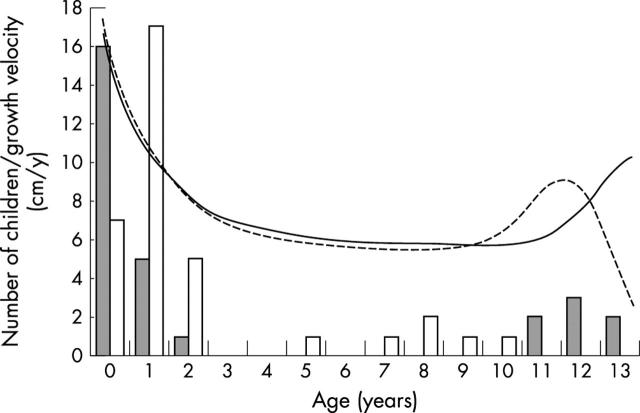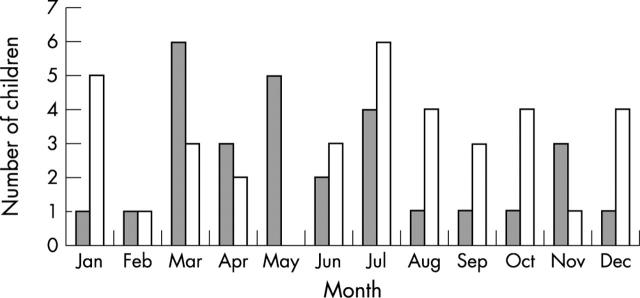Abstract
Aims: To describe the various ways in which vitamin D deficiency presents in children in selected districts of London and to identify which factors, if any, determine the mode of presentation.
Methods: Retrospective review of patients presenting to Newham General, Royal London, Great Ormond Street, and King's College Hospitals between 1996 and 2001with either hypocalcaemia or rickets caused by vitamin D deficiency. Children with plasma 25-hydroxyvitamin D levels <25 nmol/l (10 ng/ml) were considered to have vitamin D deficiency.
Results: Sixty five children, mostly from Black or Asian ethnic minority groups, were identified, 29 of whom had hypocalcaemic symptoms. Seventeen of these had no radiological evidence of rickets. The remainder (48 children) had radiological evidence of rickets with or without clinical signs. Symptoms and signs reverted to normal in all cases with vitamin D supplementation. All children who presented with symptomatic hypocalcaemia were aged either <3 or >10 years. There was a strong correlation between age at presentation and population growth velocity reference data.
Conclusions: Rickets remains a problem in the UK especially in "at risk" ethnic minority groups. Symptomatic hypocalcaemia is an important, but under-recognised presenting feature. Growth rate is likely to be an important factor in determining the mode of presentation. Unexplained hypocalcaemia should be attributed to vitamin D deficiency in "at risk" ethnic minority groups until proved otherwise.
Full Text
The Full Text of this article is available as a PDF (114.4 KB).
Figure 1.
(A) Radiograph of patient aged 1 year with severe rickets. (B) Radiograph of patient aged 11 years presenting with hypocalcaemic symptoms and no radiological evidence of rickets.
Figure 2.
Age of children with vitamin D deficiency presenting with (dark bars) and without (light bars) hypocalcaemic symptoms. Growth velocity lines12 for boys (solid line) and girls (dotted line) have been superimposed onto the graph.
Figure 3.
Month of presentation for children with (dark bars) and without (light bars) hypocalcaemia.
Selected References
These references are in PubMed. This may not be the complete list of references from this article.
- Allgrove J., Chayen J., Jayaweera P., O'Riordan J. L. An investigation of the biological activity of parathyroid hormone in pseudohypoparathyroidism: comparison with vitamin D deficiency. Clin Endocrinol (Oxf) 1984 May;20(5):503–514. doi: 10.1111/j.1365-2265.1984.tb00097.x. [DOI] [PubMed] [Google Scholar]
- Binet A., Kooh S. W. Persistence of Vitamin D-deficiency rickets in Toronto in the 1990s. Can J Public Health. 1996 Jul-Aug;87(4):227–230. [PubMed] [Google Scholar]
- DeLucia Maria C., Mitnick MaryAnn E., Carpenter Thomas O. Nutritional rickets with normal circulating 25-hydroxyvitamin D: a call for reexamining the role of dietary calcium intake in North American infants. J Clin Endocrinol Metab. 2003 Aug;88(8):3539–3545. doi: 10.1210/jc.2002-021935. [DOI] [PubMed] [Google Scholar]
- Duplechin R. Y., Nadkarni M., Schwartz R. P. Hypocalcemic tetany in a toddler with undiagnosed rickets. Ann Emerg Med. 1999 Sep;34(3):399–402. doi: 10.1016/s0196-0644(99)70137-x. [DOI] [PubMed] [Google Scholar]
- Felner E. I., Marks J. F., Germak J. A. A variation of vitamin D deficiency in children. J Pediatr Endocrinol Metab. 2001 Feb;14(2):203–206. doi: 10.1515/jpem.2001.14.2.203. [DOI] [PubMed] [Google Scholar]
- Fraser D., Kooh S. W., Scriver C. R. Hyperparathyroidism as the cause of hyperaminoaciduria and phosphaturia in human vitamin D deficiency. Pediatr Res. 1967 Nov;1(6):425–435. doi: 10.1203/00006450-196711000-00001. [DOI] [PubMed] [Google Scholar]
- Halterman J. S., Smith S. A. Hypocalcemia and stridor: an unusual presentation of vitamin D-deficient rickets. J Emerg Med. 1998 Jan-Feb;16(1):41–43. doi: 10.1016/s0736-4679(97)00240-0. [DOI] [PubMed] [Google Scholar]
- Kreiter S. R., Schwartz R. P., Kirkman H. N., Jr, Charlton P. A., Calikoglu A. S., Davenport M. L. Nutritional rickets in African American breast-fed infants. J Pediatr. 2000 Aug;137(2):153–157. doi: 10.1067/mpd.2000.109009. [DOI] [PubMed] [Google Scholar]
- Lawson M., Thomas M. Vitamin D concentrations in Asian children aged 2 years living in England: population survey. BMJ. 1999 Jan 2;318(7175):28–28. doi: 10.1136/bmj.318.7175.28. [DOI] [PMC free article] [PubMed] [Google Scholar]
- Lo C. W., Paris P. W., Holick M. F. Indian and Pakistani immigrants have the same capacity as Caucasians to produce vitamin D in response to ultraviolet irradiation. Am J Clin Nutr. 1986 Nov;44(5):683–685. doi: 10.1093/ajcn/44.5.683. [DOI] [PubMed] [Google Scholar]
- Moncrieff M. W., Lunt H. R., Arthur L. J. Nutritional rickets at puberty. Arch Dis Child. 1973 Mar;48(3):221–224. doi: 10.1136/adc.48.3.221. [DOI] [PMC free article] [PubMed] [Google Scholar]
- Mughal M. Z., Salama H., Greenaway T., Laing I., Mawer E. B. Lesson of the week: florid rickets associated with prolonged breast feeding without vitamin D supplementation. BMJ. 1999 Jan 2;318(7175):39–40. doi: 10.1136/bmj.318.7175.39. [DOI] [PMC free article] [PubMed] [Google Scholar]
- Narchi H., El Jamil M., Kulaylat N. Symptomatic rickets in adolescence. Arch Dis Child. 2001 Jun;84(6):501–503. doi: 10.1136/adc.84.6.501. [DOI] [PMC free article] [PubMed] [Google Scholar]
- Pal B. R., Shaw N. J. Rickets resurgence in the United Kingdom: improving antenatal management in Asians. J Pediatr. 2001 Aug;139(2):337–338. doi: 10.1067/mpd.2001.114877. [DOI] [PubMed] [Google Scholar]
- Sergiacomi G., Tomiselli A., Grimaldi P., Gagliarducci L., Cudillo L., Rainaldi A., Simonetti G. Aspetti dell'aspergillosi invasiva nel paziente ematologico: utilità dello studio mediante Tomografia Computerizzata e Tomografia Computerizzata ad alta risoluzione. Radiol Med. 1996 Apr;91(4):377–384. [PubMed] [Google Scholar]
- Shaw N. J., Pal B. R. Vitamin D deficiency in UK Asian families: activating a new concern. Arch Dis Child. 2002 Mar;86(3):147–149. doi: 10.1136/adc.86.3.147. [DOI] [PMC free article] [PubMed] [Google Scholar]
- Tanner J. M., Whitehouse R. H. Clinical longitudinal standards for height, weight, height velocity, weight velocity, and stages of puberty. Arch Dis Child. 1976 Mar;51(3):170–179. doi: 10.1136/adc.51.3.170. [DOI] [PMC free article] [PubMed] [Google Scholar]
- Thomas M. K., Demay M. B. Vitamin D deficiency and disorders of vitamin D metabolism. Endocrinol Metab Clin North Am. 2000 Sep;29(3):611-27, viii. doi: 10.1016/s0889-8529(05)70153-5. [DOI] [PubMed] [Google Scholar]
- Welch T. R., Bergstrom W. H., Tsang R. C. Vitamin D-deficient rickets: the reemergence of a once-conquered disease. J Pediatr. 2000 Aug;137(2):143–145. doi: 10.1067/mpd.2000.109008. [DOI] [PubMed] [Google Scholar]





